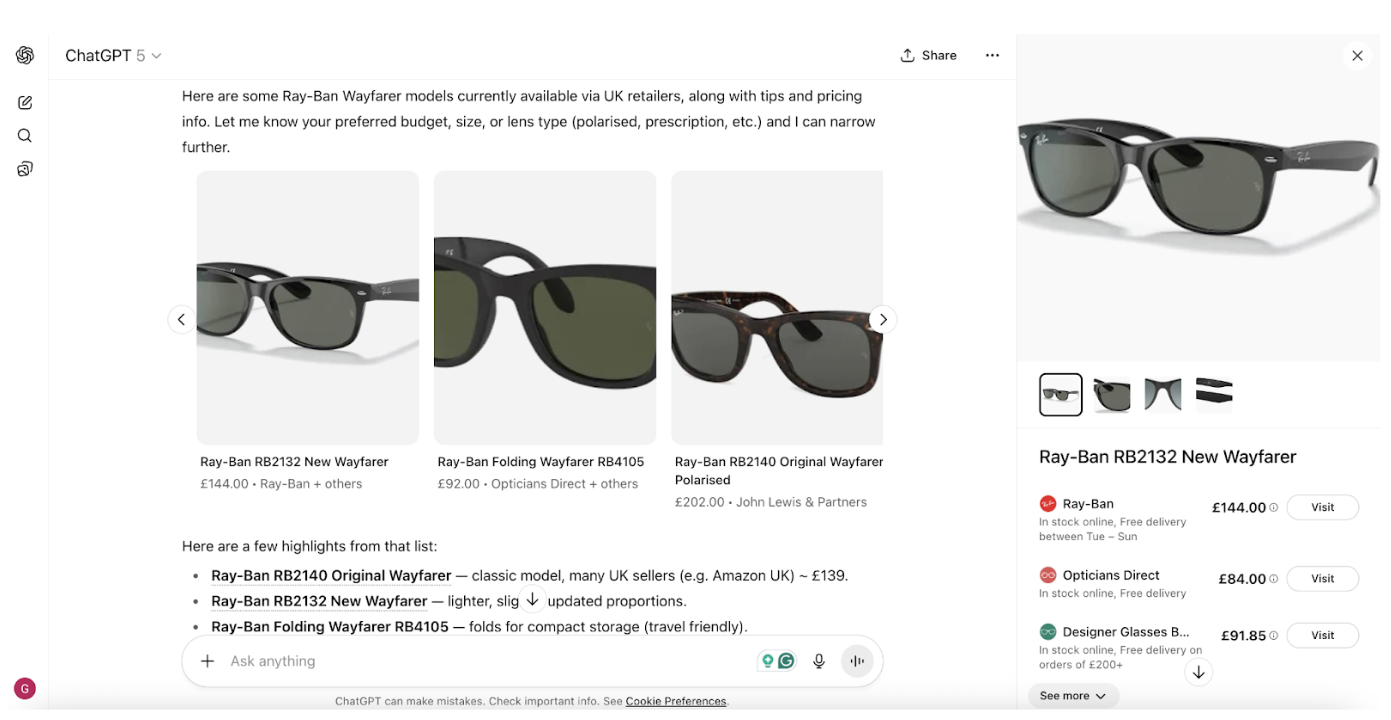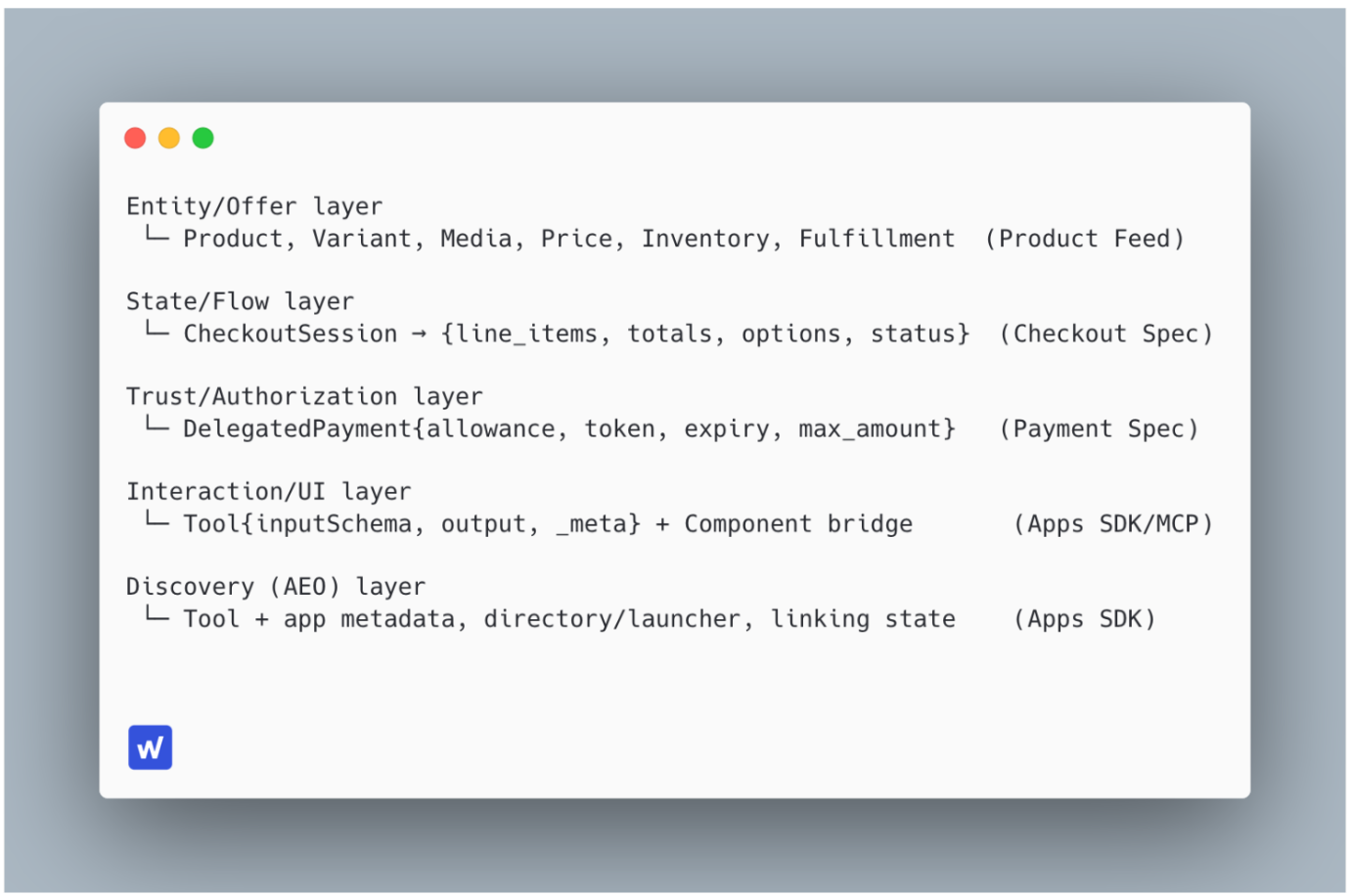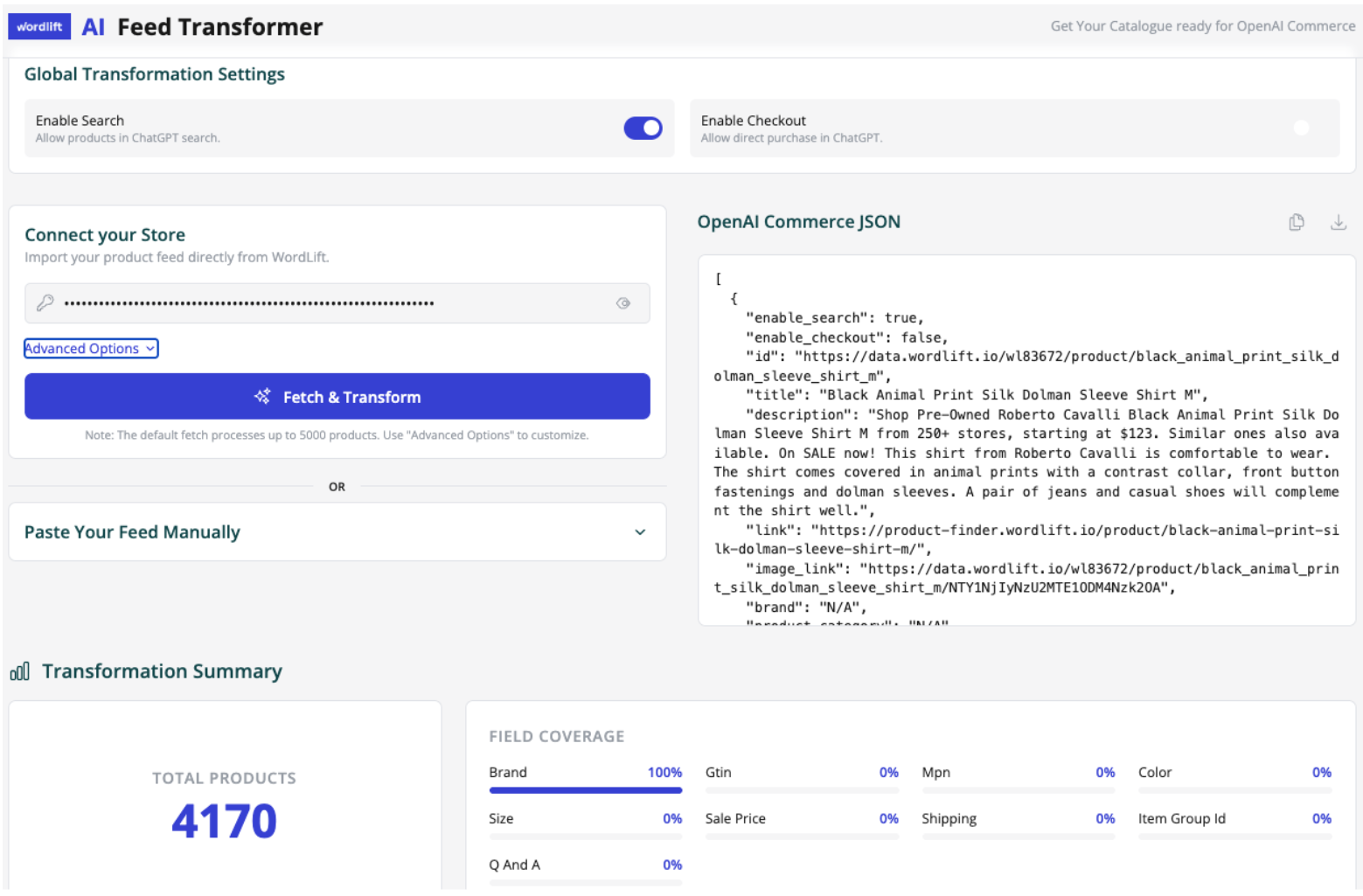The Agentic Commerce Revolution: From “Visit” to “Purchased”
The Agentic Commerce Revolution is ending the 'Visit' button, empowering AI agents to autonomously manage your purchases from discovery to delivery.
Since the ChatGPT moment, on November 30, 2022, it was clear that what we now call AI (LLMs) would have slowly then suddenly redefined the whole search engine industry.
Well, almost three years into that journey, we’re getting there. In fact, if in the last three years, LLMs have redefined a good chunk of the informational journey for search, and discovery, we’re now entering another critical phase: the redefinition of the transactional journey!
What you’re witnessing isn’t just another e-commerce interface—it’s the death of the “Visit” button.
From Discovery to Autonomous Transaction

An example of a prompt within ChatGPT, which, thanks to the semantic enrichment, enables Ray-Ban to get visibility across AI search, yet this is only the start of a journey that is moving from discovery to an entire transactional journey where the agent aligns with the human and completes the purchase.
That Ray-Ban shopping experience in ChatGPT?
It’s the last generation of AI-assisted commerce. The next generation? The AI completes the purchase for you, no redirect required.
Today’s journey is already obsolete. You ask ChatGPT about sunglasses, it surfaces Ray-Ban options with prices, and then you click “Visit Ray-Ban” to complete the purchase on their website.
Tomorrow’s reality is being built right now. You ask ChatGPT about sunglasses, it surfaces Ray-Ban options with prices, you say “Buy these for me,” and the transaction completes. Sunglasses arrive in 2 days.
No website. No redirect. No checkout form.
WordLift’s Agentic Commerce Five-Layer Semantic Stack

WordLift framework for agentic commerce.
This isn’t magic—it’s architecture. Here’s the technical foundation making autonomous commerce possible:
Layer 1: Entity/Offer (The Product Feed)
Your catalog becomes AI-readable. GTIN codes, variant structures, inventory status, fulfillment options—all mapped to standardized schemas that agents can parse and reason over. If Ray-Ban’s sunglasses aren’t properly structured here, they don’t exist to the AI.
Layer 2: State/Flow (The Checkout Spec)
The AI manages your cart state. Canonical endpoints expose line items, totals, shipping options, and order status. The agent doesn’t just read your catalog—it can modify cart contents, apply discounts, and progress through checkout states just like a human would.
Layer 3: Trust/Authorization (Delegated Payment)
Secure tokenized transactions without exposing card data. Built on protocols like OpenAI‘s Agentic Commerce Protocol (ACP) with Stripe, this layer lets users authorize spending limits and expiry windows. The agent can spend on your behalf, but within boundaries you control.
Layer 4: Interaction/UI (Apps SDK/MCP)
How the agent renders and reasons. This layer separates structured data (what the model thinks about) from presentation data (what you see). The agent understands “Ray-Ban Wayfarer, $139, in stock” internally, then renders it conversationally: “I found these classic Wayfarers for you.”
Layer 5: Discovery (AEO Surface)
How brands get selected in the first place. This is SEO 3.0: metadata, prior usage patterns, context matching, and linking state. If you’re not optimized here, you never enter the consideration set. The best product feed in the world is worthless if the agent never thinks to query you.
The WordLift Bridge: Theory Meets Practice

WordLift automatically transforms your existing catalog into OpenAI-compliant schemas.
Two critical toggles control everything: enable_search makes your products discoverable in ChatGPT, while enable_checkout allows direct purchase completion without leaving the chat.
Behind the scenes, it generates the OpenAI Commerce JSON, which maps your inventory, pricing, variants, and fulfillment into a semantic layer that agents can understand.

This is the infrastructure play. While brands debate which AI search tool to buy, the smart ones are rebuilding their data foundations.
The Core Insight
“Most brands are still optimizing surface content. Most brands are still figuring out if they need Profound, OtterlyAI or Scrunch. The reality is that the real bottleneck is deeper: your data shape.“
Translation: You can’t prompt-engineer your way into an agent’s shopping cart if your product data isn’t semantically structured.
The old bottleneck was SEO rankings, ad spend, and conversion rate optimization. The new bottleneck is data legibility, schema compliance, and API readiness. If your catalog isn’t machine-readable in the way agents expect, you don’t exist. No amount of marketing budget fixes that.
What Changes (And What Doesn’t)
The “Visit” button dies. Redirects to external sites become friction. Website traffic as a KPI becomes meaningless when agents don’t browse, they transact. Traditional conversion funnels collapse when purchase happens in one message. Page-based SEO matters less when ChatGPT never sends users to your site.
Trust and authorization survive. Users still control spending limits and agent permissions. Physical fulfillment remains unchanged—someone still ships the sunglasses. Brand differentiation still matters because the agent needs reasons to pick Ray-Ban over Oakley. Customer service endures because returns, exchanges, and support still require human interaction.
Something new emerges: Semantic SEO (SEO 3.0). Brands optimize for agent discoverability, not page rankings. This is invocation over indexation—brands aren’t found, they’re called by agents. Data shape becomes a competitive moat because the best-structured catalog wins. Product design shifts to agent-first thinking, with descriptions, variants, and attributes optimized for AI reasoning rather than human browsing.
What’s Next for Agentic Commerce?
The specs are public. The standards are open. OpenAI’s Product Feed Specification is live and documented. Agentic Commerce Protocol (ACP) is built with Stripe and open to any merchant. Model Context Protocol (MCP) provides the foundation for Apps SDK integration.
What’s missing? Your data mapped to them.
Don’t start by buying more AI search trackers or optimizing prompts without structured data. Don’t build custom LLM interfaces before fixing your backend. That’s building a penthouse on quicksand.
Start here: Audit your product data. Do you have clean GTIN/MPN codes? Structured variants? Real-time inventory status? If not, you’re not ready for agentic commerce. Then map to OpenAI’s Product Feed Spec using tools like WordLift’s Feed Transformer or custom pipelines. Your catalog must speak the semantic language agents understand.
Next, implement checkout state endpoints that expose canonical APIs for creating, modifying, and completing a cart. The agent needs to manage the state, not just read it. Enable delegated payment infrastructure by integrating with ACP-compatible payment processors. Tokenized, constrained authorization is non-negotiable.
Finally, optimize for discovery (AEO) through metadata, categorization, and context matching. If the agent doesn’t think of you, your perfect product feed is worthless.